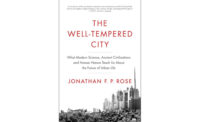Two museums by Frank Gehry redefine their settings, and RECORD looks at challenges of success for popular urban centers.
 |

Don't be confused if the issue of ARCHITECTURAL RECORD you're reading doesn't look like everyone else's. We created two covers this month—half of our readers are receiving one, and half the other—because two very different museums, both designed by Frank Gehry, are opening in October, and each has a compelling story about its design and construction. Maybe you're looking at the magazine with the highly anticipated Fondation Louis Vuitton museum in Paris on the cover—an amazing composition of huge curving glass canopies wrapped around a white-paneled structure, which looks both grounded and about to take flight. Or maybe you have the cover that shows an aerial view of the Biomuseo in Panama City, a small, plucky concrete building with a vibrant roof of brightly colored angled metal, designed for an institution devoted to the biodiversity of that tropical region. The Paris and Panama museums were each inspired by their settings, and each displays an ingenious use of unconventional forms that is a Gehry hallmark. But, yes, they differ vastly in ambition, construction, and budget (though no one is confirming what the elaborate and finely detailed Paris project actually cost). Both covers were beautifully shot by RECORD contributing photographer Iwan Baan.
Such architectural projects are a major component of city life (images of the Biomuseo became a branding logo for Panama before the museum was even finished). And in this issue we explore the rising popularity of urban living in America, and one of the biggest problems accompanying that trend: the affordable-housing crunch. Taking three in-demand cities as case studies—Boston, New Orleans, and Portland, Oregon—we explore the forces that are pushing up the population and accelerating rents, and report on some solutions that the public and private sectors are pursuing. Our Building Types Study this month details the designs of exemplary low-income and affordable-housing projects, focusing on those in cities with mild climates, where architects have made the most of indoor/outdoor space. We also look at market-rate and micro housing that could serve as prototypes for innovative solutions.
In New York, where RECORD is based, the drama of the housing squeeze is unfolding under Mayor Bill de Blasio, who has made the creation of more affordable housing a key goal for his administration. The challenges are enormous: this is a city where a developer of luxury condos is selling parking spaces for $1 million each, while the public housing authority's waiting list for apartments numbers 250,000 households. Caught between the super-rich and the truly needy are low- and middle-income working people, many priced out of the market by a lack of supply. Authorities have looked to the private sector to fill the gap, offering tax breaks and other incentives for including 20 percent low-income or affordable apartments in new market-rate projects. But this policy recently received unwelcome publicity with the revelation that subsidized tenants in at least one new building must use a separate entrance, dubbed the “poor door.”
While a separate unequal entry and lobby is a terrible idea, mixing income levels in one complex is not. Cities thrive on diverse populations that live together in neighborhoods throughout the urban realm, sharing the transit systems and schools and patronizing varied commercial enterprises. To keep the vital socioeconomic mix in the work force requires a range of housing options—for the young and seniors, for the rich and poor, and for the vast middle in between. In most rapidly growing cities, that means creative thinking—to alter zoning, allow for greater density, encourage mixed use, revise outmoded parking requirements, and improve public transit. Keeping up the supply of housing to meet new demands will help control spiraling costs, but what we also need are new models and new ideas—and that's where architects are playing a major role in the future of flourishing cities.




